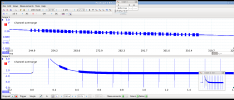deeptho
Specialist Contributor
- Joined
- Apr 7, 2006
- Messages
- 700
- Reaction score
- 422
- Points
- 63
- Age
- 57
- My Satellite Setup
- Wavefrontier T90, Laminas 120cm, 2 other dishes; tbs 5927, tbs6904, tbs6909x, tbs6903x, tbs5990, tbs6981,tbs5927
- My Location
- Europe
I have an old amiko dm3800 rotor, carrying a laminas 1.2 M dish.
This mostly worked fine.
Now yesterday I suddenly noticed a very strange problem: frequently the dish did
not want to move and the LNB did not even produce a signal. After a lot of trouble shooting
it became clear that the LNB and the switch behind the positioner did not receive any power,
which leads me to believe that the positioner activates its over-current protection.
I think this over-current activations occurs even when the dish does not receive any commands
to move. The LNB is fine. I think my Amiko has a hardware problem. Did anyone experience something
similar?
Below is the full detective story.... and a work around. :->
First some background: As the dish started to develop some slack, I tightened the slack adjustment a few
months ago. At that time, I also measured the current, which sometimes peaked
between 300 and 350 mA when moving the dish. A bit on the high side, but it worked.
So my first thought was that the motor draws too much current, perhaps due to the hot weather which might
cause extra tightening. This was not the problem although the currents I measured were still a bit on the high side.
Why led me to believe that it is an overload is that this problem only occurs when using a V-polarised mux
(so 18 Volt) and never on an H-mux. Now here is the strange thing: after some further experimentation,
and measuring voltages and currents, it became clear that this problem occurs even when not sending
any dish-move commands. So the motor did not even have to run. Simply tuning to an H-transponder
made the Amiko power off the LNB quite consistently.
I did have a swicth installed between the Amiko and the LNB, but removing it did not make a difference.
So it is strange: the Amiko cannot even handle this normal use case of an LNB directly connected to
the positioner anymore.
Then I had another little breakthrough: recently I made some changes to the blindscan drivers to fix a
very old issue: most TBS cards never power off the diseqc equipment and LNBs (Perhaps this is the
reason I have accumulated a bog box of faulty LNBs over the years?). This consumes needless power.
It also prevents the use of priority swicthes and such.
I had fixed this recently and it turned out this was actually why I started seeing problems with the Amiko.
The old "keep all equipment always powered on" seems to have camouflaged the problem
with the Amiko perhaps for a very long time. Fixing this bug exposed the problem.
To test my theory of an overload, I made a software workaround: whenever the LNB needs to go from 0 to 18 Volt,
I now do that in two steps: first I power up to 12 Volt. I wait a little while and then switch to 18 Volt. The
idea is that the problem is that the Amiko does not handle well starting all devices (including itself) at the
same time and thus goes into overload mode. Starting with 12 volt power limits startup currents and
keeps the Amiko happy.
This actually works, but it should not be necessary, should it?
This mostly worked fine.
Now yesterday I suddenly noticed a very strange problem: frequently the dish did
not want to move and the LNB did not even produce a signal. After a lot of trouble shooting
it became clear that the LNB and the switch behind the positioner did not receive any power,
which leads me to believe that the positioner activates its over-current protection.
I think this over-current activations occurs even when the dish does not receive any commands
to move. The LNB is fine. I think my Amiko has a hardware problem. Did anyone experience something
similar?
Below is the full detective story.... and a work around. :->
First some background: As the dish started to develop some slack, I tightened the slack adjustment a few
months ago. At that time, I also measured the current, which sometimes peaked
between 300 and 350 mA when moving the dish. A bit on the high side, but it worked.
So my first thought was that the motor draws too much current, perhaps due to the hot weather which might
cause extra tightening. This was not the problem although the currents I measured were still a bit on the high side.
Why led me to believe that it is an overload is that this problem only occurs when using a V-polarised mux
(so 18 Volt) and never on an H-mux. Now here is the strange thing: after some further experimentation,
and measuring voltages and currents, it became clear that this problem occurs even when not sending
any dish-move commands. So the motor did not even have to run. Simply tuning to an H-transponder
made the Amiko power off the LNB quite consistently.
I did have a swicth installed between the Amiko and the LNB, but removing it did not make a difference.
So it is strange: the Amiko cannot even handle this normal use case of an LNB directly connected to
the positioner anymore.
Then I had another little breakthrough: recently I made some changes to the blindscan drivers to fix a
very old issue: most TBS cards never power off the diseqc equipment and LNBs (Perhaps this is the
reason I have accumulated a bog box of faulty LNBs over the years?). This consumes needless power.
It also prevents the use of priority swicthes and such.
I had fixed this recently and it turned out this was actually why I started seeing problems with the Amiko.
The old "keep all equipment always powered on" seems to have camouflaged the problem
with the Amiko perhaps for a very long time. Fixing this bug exposed the problem.
To test my theory of an overload, I made a software workaround: whenever the LNB needs to go from 0 to 18 Volt,
I now do that in two steps: first I power up to 12 Volt. I wait a little while and then switch to 18 Volt. The
idea is that the problem is that the Amiko does not handle well starting all devices (including itself) at the
same time and thus goes into overload mode. Starting with 12 volt power limits startup currents and
keeps the Amiko happy.
This actually works, but it should not be necessary, should it?



